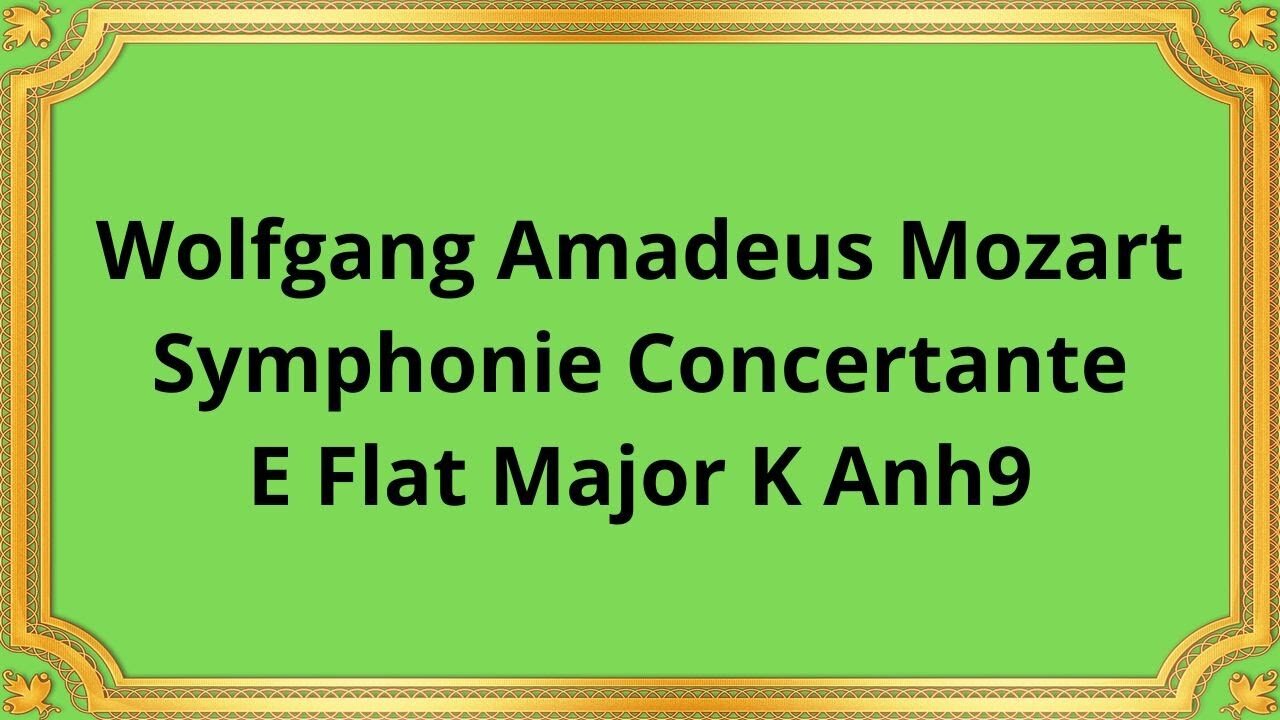Premium Only Content

Wolfgang Amadeus Mozart Symphonie Concertante E Flat Major K Anh9
#Mozart#Chamber_music#Classical_music#Symphony#Musical_composition
Publication date 1950
VIENNA PHILHARMONIC WIND GROUP
and CHAMBER ORCHESTRA of the VIENNA STATE OPERA
Conducted by HENRY SWOBODA
Wolfgang Amadeus Mozart is known for his contributions to the classical music genre, and his Symphonie Concertante E Flat Major K Anh 9 is no exception. Composed in the late 18th century, this work is a showcase of Mozart's musical talent, both as a composer and as a performer. In this article, we will delve into the composition of Mozart's Symphonie Concertante E Flat Major K Anh 9 and explore its significance in the classical music world.
Mozart composed the Symphonie Concertante E Flat Major K Anh 9 in 1779, during his tour of Europe as a child prodigy. The work was likely commissioned by one of Mozart's patrons and was intended to be performed by a small orchestra.
The Symphonie Concertante E Flat Major K Anh 9 is written for four solo instruments: violin, viola, cello, and French horn. It is composed of three movements:
Allegro maestoso
Andante
Presto
The first movement, Allegro maestoso, is a fast-paced and energetic piece that highlights the virtuosic abilities of the soloists. The second movement, Andante, is a slow and lyrical piece that showcases Mozart's skill at composing beautiful melodies. The final movement, Presto, is a lively and spirited piece that brings the symphony to a thrilling conclusion.
The Symphonie Concertante E Flat Major K Anh 9 is significant in the classical music world for several reasons. Firstly, it is a rare example of a symphony written for four solo instruments. The combination of violin, viola, cello, and French horn creates a unique and harmonious sound that is unlike any other symphony. Secondly, the work highlights Mozart's ability to compose complex and beautiful music, while also showcasing his skill as a performer. Thirdly, the work reflects the development of the classical music style in the late 18th century, with its emphasis on balance, structure, and clarity.
Conclusion
In conclusion, Mozart's Symphonie Concertante E Flat Major K Anh 9 is a masterpiece of classical music that showcases Mozart's exceptional talent as a composer and performer. Its unique combination of four solo instruments creates a harmonious and beautiful sound that is unmatched in the symphonic genre. Moreover, its significance in the development of the classical music style cements its place as an essential piece of music history.
-
 24:35
24:35
Classical music_Music Inspiration
30 days agoMax Bruch Violin Concerto No. 1 in G minor, Op. 26
891 -
 2:02:53
2:02:53
Badlands Media
11 hours agoBaseless Conspiracies Ep. 149: Epstein Docs, Charlotte Stabbing, and Trump’s Next Moves
39.4K9 -
 2:56:12
2:56:12
TimcastIRL
6 hours agoTrump SLAMS Democrats Over Irina Zarutska Killing, Says WAR Over Chicago Crime | Timcast IRL
175K101 -
 29:08
29:08
Afshin Rattansi's Going Underground
1 day agoCol. Lawrence Wilkerson: World War 3 is ALREADY HERE, Netanyahu is INTENT on Greater Israel
18.6K23 -

SpartakusLIVE
8 hours agoNONSTOP Snipes, Rockets, and BICEPS = Monday MOTIVATION
64.5K1 -
 6:31:35
6:31:35
Rallied
9 hours ago $3.11 earnedSolo Challenges All Day
55K2 -
 1:27:53
1:27:53
Flyover Conservatives
11 hours agoIs AI Actually Alien Intelligence? Dr. Jason Dean Exposes the Dark Side | FOC Show
41.3K3 -
 1:47:36
1:47:36
Glenn Greenwald
8 hours agoJD Vance and Rand Paul Clash on Due Process: War on Terror Echoes; Has the U.S. Given Up on Confronting China? Ben Shapiro's Latest Falsehoods About Israel | SYSTEM UPDATE #510
108K83 -
 LIVE
LIVE
RaikenNight
6 hours ago $1.92 earnedExploring the Galaxy of No Mans Sky
1,025 watching -
 LIVE
LIVE
Spartan
7 hours agoRanked and Expedition 33 (NG+4 and all enemies Set to 10x health)
167 watching